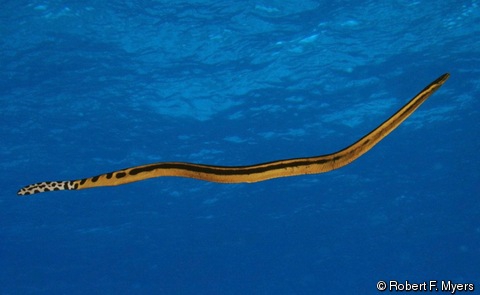| Citation |
|
Description |
Geographic Range [top]
Range Description: This species is very widespread in the tropical parts of the Pacific and Indian Oceans between the 18-20º C isotherms (Dunson and Ehlert 1971, Graham et al. 1971). It is known from the coasts of eastern Africa, north to the Arabian Gulf, east along the Asian coast of the Indian Ocean to the Pacific Ocean, northward to Japan and eastward to the western coasts of the Americas (Heatwole 1999).
Currents occasionally carry the snakes into temperate waters, but these are almost certainly far from their breeding and feeding waters.
Countries occurrence:
Native:
American Samoa (American Samoa); Australia; Bahrain; Bangladesh; Cambodia; China; Christmas Island; Cocos (Keeling) Islands; Colombia; Costa Rica; Djibouti; Ecuador (Ecuador (mainland), Galápagos); El Salvador; Eritrea; Fiji; French Polynesia; Guatemala; Honduras; India (Andaman Is., Nicobar Is.); Indonesia; Iran, Islamic Republic of; Iraq; Japan; Kenya; Kiribati; Korea, Democratic Peoples Republic of; Korea, Republic of; Kuwait; Madagascar; Malaysia; Mauritius; Mayotte; Mexico; Micronesia, Federated States of ; Mozambique; Myanmar; Nauru; New Caledonia; Niue; Oman; Pakistan; Palau; Panama; Papua New Guinea; Philippines; Pitcairn; Qatar; Réunion; Samoa; Seychelles; Singapore; Solomon Islands; Somalia; South Africa; Sri Lanka; Taiwan, Province of China; Tanzania, United Republic of; Thailand; Tokelau; Tonga; Tuvalu; United Arab Emirates; United States (Hawaiian Is.); United States Minor Outlying Islands (Howland-Baker Is., Johnston I., US Line Is.); Vanuatu; Viet Nam; Wallis and Futuna; Yemen
FAO Marine Fishing Areas:
Native:
Indian Ocean – western; Indian Ocean – eastern; Pacific – northwest; Pacific – southwest; Pacific – western central; Pacific – southeast; Pacific – eastern central
Additional data:
? Lower depth limit (metres): 10
Range Map: Click here to open the map viewer and explore range.
Population [top]
Population: Although there is no specific population information about the species, it is thought to be stable.
This is a fairly common species throughout the waters of the Indian sub-continent, occasionally washed ashore during rough weather, which is probably due to its pelagic habits. For the same reason, it is also rarely encountered as bycatch in fishing operations (A. Lobo pers. comm.).
Kropach (1975) marked 961 individuals of this species in the Bay of Panama over a one year period. None were recaptured during the period. About a year later, one was recaptured in the Bay of Panama and three were collected off the coast of Mexico.
Estimating population size for this species is difficult, as the range is very broad over several oceans. In addition, the distribution pattern of Pelamis is very clumped. Visual surveys from boats are probably the most suitable technique for estimating population size. The unique habits and colouration of Pelamis mean that it is unlikely to be confused with other species (Marsh et al. 1993).
Current Population Trend: Stable
Additional data:
? Population severely fragmented: No
Habitat and Ecology [top]
Habitat and Ecology: The species is the most pelagic of the sea snakes, occurring in the open ocean well away from coasts and reefs. However, a small individual (total length = 230 mm) found in a mangrove swamp (Minton 1966) suggests that the species may occasionally occur in inter-tidal habitats. This species eats only fish (Klawe 1963) that mistakenly seek shelter beneath the motionless snake that resembles drifting wood. Consequently they forage to a depth of only about 2 m (Kropach 1975). This species is usually found in the 0-10 m range of the water column (Cogger 2007). This is the only marine snake not associated with the benthic community (Marsh et al. 1993).
In the open ocean, the snakes often occur in large numbers in association with long lines of debris. These "slicks" form in calm seas and consist variously of debris, foam and scum brought together by converging water currents. In some areas, such as the Gulf of Panama in the eastern Pacific Ocean, the slicks can vary in width from 1 to 300 m and stretch for many kilometres. Several thousand snakes may be associated with a single slick. It is not clear whether the snakes actively swim to the slicks or whether they are carried into them passively (Kropach 1971, 1975). The only obvious activity that is performed by the snakes in the slicks is feeding and knotting. Other activities that might benefit from large aggregations, such as mating, have not been observed. Females are significantly larger than males (Kropach 1975).
The minimum snout-vent length at birth is about 22 cm and sexual maturity is reached as a length of 50 cm and 62.5 cm for males and females respectively (Marsh et al. 1993).
Systems: Marine
Congregatory: Congregatory (and dispersive)
Threats [top]
Major Threat(s): There are no known major threats to this species. Minor threats may include bycatch in squid fisheries (M. Guinea pers. comm. 2009), ghost fishing nets, and pollution, including oil spills.
Conservation Actions [top]
Conservation Actions: There are no species-specific conservation measures in place.
No sea snake species is currently listed by CITES (the Convention on International Trade in Endangered Species of Wild Fauna and Flora).
Citation: Guinea, M., Lukoschek, V., Cogger, H., Rasmussen, A., Murphy, J., Lane, A., Sanders, K. Lobo, A., Gatus, J., Limpus, C., Milton, D., Courtney, T., Read, M., Fletcher, E., Marsh, D., White, M.-D., Heatwole, H., Alcala, A., Voris, H. & Karns, D. 2010. Pelamis platura. The IUCN Red List of Threatened Species 2010: e.T176738A7293840. http://dx.doi.org/10.2305/IUCN.UK.2010-4.RLTS.T176738A7293840.en. Downloaded on 19 October 2016.
Disclaimer: To make use of this information, please check the .
Feedback: If you see any errors or have any questions or suggestions on what is shown on this page, please provide us with feedback so that we can correct or extend the information provided
|


